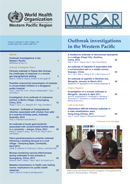An outbreak of acute gastroenteritis associated with contaminated bottled water in a university – Jiangxi, China, 2012
DOI:
https://doi.org/10.5365/wpsar.2012.3.4.009Abstract
Background: On 23 May 2012, a university in Jiangxi, China reported a gastroenteritis outbreak. We investigated the outbreak to identify the agent, source and mode of transmission and to recommend control measures.
Methods: A case was defined as any person from the university with onset of diarrhoea (>3times/24h) from 1 to 31 May 2012. Active case finding was conducted by reviewing university hospital and drug-store records and interviewing students, workers and teachers. We then conducted a case-control study in which we compared food, water and environmental exposure history. Water samples were collected and tested.
Results: We identified 417 cases – an attack rate (AR) of 4.7% (417/8781) for the university. There were 416 student cases (AR = 5.7%) distributed across all 11 colleges, five of which were more heavily affected (AR range = 5.9%–14%). In the case-control study, cases had higher odds of having drunk bottled water (odds ratio [OR] = 4.1; 95% confidence interval [CI] = 1.7–9.9), and there was a dose–response relationship (X2trend = 4.6, P < 0.05). Drinking boiled bottled water was inversely associated with being a case (OR = 0.22, 95% CI = 0.07–0.71). Eating in any of the three university canteens or drinking water from the city water supply was not associated with being a case. Pathogenic Escherichia coli was isolated from two unopened bottled water specimens and from four student cases.
Conclusion: This gastroenteritis outbreak was most likely caused by contaminated bottled water. The company in question has been shut down and no further cases have been reported. Increased regulation of bottled water plants and better coordination between different investigators for future outbreaks is recommended.

